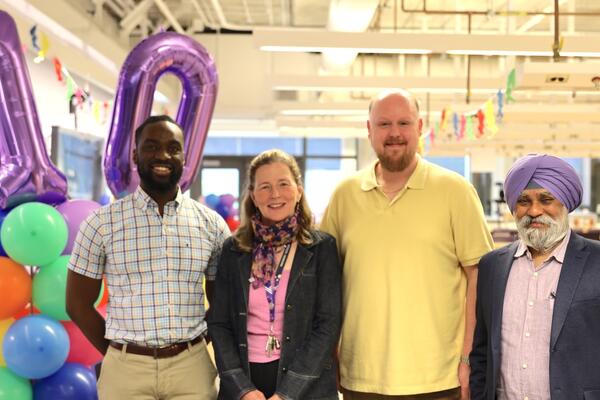
Blueprint helps not-for-profits with tech
Started at UC Berkeley in 2012, Blueprint partners with not-for-profit organizations to create technology free of charge

Started at UC Berkeley in 2012, Blueprint partners with not-for-profit organizations to create technology free of charge
By Carol Truemner Faculty of EngineeringWhen Luisa San Martin heard about Blueprint on a co-op term at Google in Seattle, she knew the student team was the ideal fit for Waterloo. Started at UC Berkeley in 2012, Blueprint partners with not-for-profit organizations to create technology such as websites, mobile applications and analysis tools — all free of charge.
“Some of my fellow interns at Google were members of the team in California,” says San Martin, a software engineering student. “When I found out more about it, I thought it was a really cool idea and one that I wanted to bring to Waterloo.”
In September 2016, San Martin co-founded the team’s second chapter and first one in Canada along with Katrina Crisostomo, a Waterloo biology student at the time. Launching a Blueprint chapter also resonated with Crisostomo after meeting Berkeley team members while on a co-op term.
Waterloo’s chapter has 23 active members who all volunteer their time. The majority are second to fourth-year engineering and math students, with science and arts students rounding out the team.
When each semester begins, the members decide what non-profits they want to work with during the school term. The projects selected are ones where technology as a solution makes sense.
“We then contact the chosen non-profits and let them know who we are, what we do and how we can help them,” says San Martin, Blueprint’s president.
Waterloo team members remain connected to the Berkeley chapter through video conferencing every couple of months.
“Whenever we need advice or feedback we’ll talk to them,” says San Martin. “They sometimes help us with project solutions or we’ll let them know about our projects that might be beneficial to them.”
Waterloo’s Blueprint is currently working on projects with three different groups: Help Lesotho, the Waterloo Wellington Children’s Groundwater Festival and Friends of the Earth.
Headquartered in Ottawa, Help Lesotho helps bridge the education gap in Lesotho, a country in South Africa ravaged by HIV and AIDS that has wiped out its middle generation. Blueprint members are building an app for both young adults and the grandparents who are raising them to provide information about sex and sexually transmitted infections and a forum where difficult questions can be asked anonymously.
“Lesotho is a country where data is very expensive so we need to build an app that’s very data light,” says San Martin. ”That’s an interesting challenge for a North American developer because we’re used to data that’s easy to come by.”
The annual Waterloo Wellington Children’s Groundwater Festival educates students about water consumption. Blueprint members are developing an app that will act a virtual assistant to provide all the information needed by the 250 teachers and 1,200 parent volunteers to guide over 5,000 students through over 50 activities at the week-long event.
Corina McDonald, the programming committee member for the festival, says the app will include everything from what students will need to bring with them to which activities are most suited to their grade.
“As a not-for-profit organization, the festival depends on support from community members to help educate our children, both big and small, on how we consume, manage, protect and conserve water,” says McDonald, the curator of the University of Waterloo’s Earth Sciences Museum, which has been part of the festival since its launch in 1994. “Blueprint is helping us bring current technology to the festival, something that we otherwise would not have had the support for.”
Friends of the Earth is an international organization that provides a voice for the environment. The focus of the Canadian chapter is on educating people about the critical decline in bee populations. Blueprint members are working on an app to allow people to take pictures of bees and upload them for scientists to analyze. The app also provides information on how to make gardens bee-friendly.
San Martin, a member of the Friends of the Earth project, has always been interested in environmental issues, as well as volunteering for a good cause. She comes by her desire to give back naturally: her mother volunteers at a nursing home and her father on the soccer field as a coach. San Martin’s parents, who are both engineers, were also strong role models when it came to their daughter deciding on a university program.
Armed with a year’s experience leading Blueprint, San Martin, along with two other team members, will further develop the Waterloo chapter as their fourth-year engineering Capstone Design project.
A new Blueprint president will be selected before San Martin graduates next year. She plans to help with the leadership transition before stepping down from the team as co-founder Crisostomo did when she finished her degree last spring. San Martin says the team will continue to thrive under someone else’s leadership and fresh ideas.
“The members really like the idea of building tech for social good,” she says. “Like me, they like that they’re building something that is going to be used to help other people’s lives in an impactful way.”
For more information – The Benefits of Joining Blueprint

Read more
The Waterloo community comes together to remember, reflect and respond to gender-based violence

Read more
Shop Canadian this holiday season with festive porch plants, fashion-forward apparel, craft spirits and more from Waterloo entrepreneurs

Read more
The Pearl Sullivan Engineering IDEAs Clinic marks a decade of delivering experiential learning embedded in the real world and mentored by industry professionals
The University of Waterloo acknowledges that much of our work takes place on the traditional territory of the Neutral, Anishinaabeg, and Haudenosaunee peoples. Our main campus is situated on the Haldimand Tract, the land granted to the Six Nations that includes six miles on each side of the Grand River. Our active work toward reconciliation takes place across our campuses through research, learning, teaching, and community building, and is co-ordinated within the Office of Indigenous Relations.